|
 Campanella tristis Campanella tristis
SynonymsMarasmiellus tristis
Delicatula dorotheae
Resupinatus dorotheae
Resupinatus tristis
BiostatusPresent in region - Indigenous. Non endemic
Images (click to enlarge)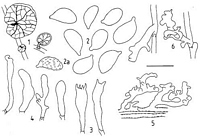
Caption: Campanella tristis. 1. Basidiomes
(PDD 60254); 2, spores; 2a, a shrunken spore of C. tristis (PDD 60254);
3, basidia (PDD 29267); 4, cheilocystidia (PDD 60254): 5, pileipellis elements
(PDD 60256); 6, caulocystidia (PDD 61125). | 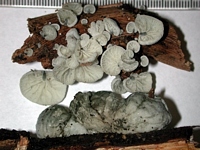
Owner: J.A. Cooper | 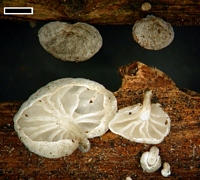
Caption: scale=2mm
Owner: J.A. Cooper | 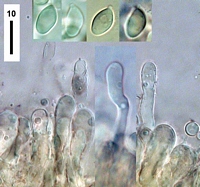
Caption: spores and cheilocystidia
Owner: J.A. Cooper | 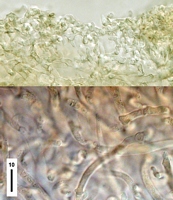
Caption: coralloid pileus surface hyphae and subcuticular hyphae
Owner: J.A. Cooper | 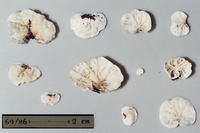
Caption: ZT69-086
Owner: E. Horak: © Creative Commons Attribution-Noncommercial 3.0 New Zealand | 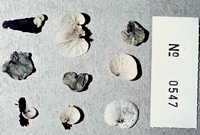
Caption: ZT0547
Owner: E. Horak: © Creative Commons Attribution-Noncommercial 3.0 New Zealand | 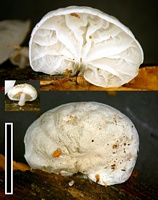
Caption: scale=1cm
Owner: J.A. Cooper | 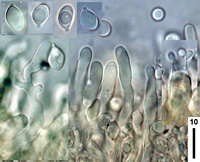
Caption: spores, basidium &cheilocystidia
Owner: J.A. Cooper | 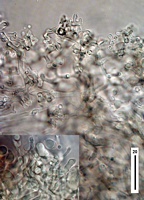
Caption: cap section. Lower left: thin cheilocystidia.
Owner: J.A. Cooper | 
Caption: 87-Delicatula dorotheae: a. spores. | 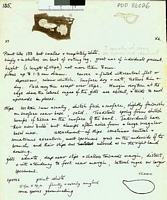
Caption: Watercolour
Owner: G.M. Taylor | 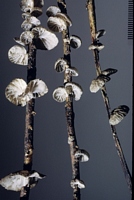
Owner: Herb. PDD | 
Caption: 326-Marasmiellus tristis: a. spores; b. cuticle (2000 x). | 
Caption: Fig. 45 | 
Caption: Fig. 44 | 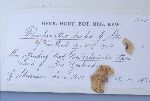
Caption: Type specimen, Kew
Owner: B.P. Segedin |
Article: Segedin, B.P. (1993). Studies in the Agaricales of New Zealand: some new and revised species of Campanella (Tricholomataceae: Collybieae). New Zealand Journal of Botany 31: 375-384 (http://www.rsnz.org/publish/abstracts.php).
Description: Description based on the type material, together
with additional information from further collections
Pileus 4-30 mm diam., semi-orbicular to reniform,
surface drab white, cream or pale grey, turning glaucous or greenish-grey and
finally black with age, drying buff to ochraceous, moist, flabby to gelatinous
in texture, translucent when wet, floccose when dry, surface tessellate, following
outline of lamellae, margin inrolled. Hymenophore of well-spaced lamellae, simple
or intervenose, white, becoming dingy, staining verdigris, greenish or black
when aged, drying chrome. Lamellae attached to slightly decurrent when stipe
obvious, thin, simple, in one series in smaller basidiomes, forking or strongly
intervenose in larger ones, cross-veining usually slightly below the level of
the radiating main veins. Stipe 2-3 x 1 mm, lateral or excentric, fibrous, downy
fibrillose, straight or more often geotropically curved, even, sometimes attached
to the substratum by pad of mycelium.
Spore print white. Smell none, taste unknown.
Spores 8.0-10.5 x 5.5-7.0 (8.5 x 6.0) µm, Q = 1.4, somewhat variable in shape
and size, broadly ellipsoid to humped on the abaxial side, hyaline, inamyloid,
not dextrinoid, acyanophilic, thin-walled, sometimes with one large guttule
or many, apiculus broad. Spores appear to shrivel easily developing the longitudinal
ridges depicted by Stevenson (1964) for R. dorotheae. Basidia 20-35 x
5-10 µm, clavate, with 4 sterigmata 4.5 µm long. Cheilocystidia on the lamellar
margin 30-40 x 3 µm, versiform but basically clavate, sometimes with various
short protuberances, in clusters of 3-6 but not very plentiful. Pleurocystidia
absent. Trama of hyaline, strongly gelatinised, interwoven hyphae up to 4 µm
diam., with conspicuous, medallion clamp connections. Subhymenium narrow, of
closely interwoven hyphae, somewhat gelatinised. Context of thin, gelatinised,
interwoven hyphae like the trama. Pileipellis an indistinct cutis of irregularly
arranged, repent, sometimes faintly encrusted hyphae giving rise to curving,
erect, diverticulate hyphae in a Rameales to asterostromelloid structure, hyaline
to stramineous in colour, sometimes with resinous incrustations to which spores
readily cling. Subpellis faintly yellow in KOH. Stipe cortex of narrow (2µm
diam.) hyphae producing numerous caulocystidia of Rameales structure, golden
brown in ammonia. Chemical reactions; KOH on pileus gives a brownish colour,
phenol gives a darker than natural verdigris tinge.
Habitat: Caespitose and gregarious on dead wood of
the indigenous species Beilschmiedia tawa (A. Cunn.) Benth. & Hook.
f. ex Kirk (tawa), Geniostoma ligustrifolium A. Cunn. (hangehange), Rhipogonum
scandens J. R. & G. Forst. (supplejack), Kunzea ericoides (A.
Rich.) J. Thompson (kanuka), Freycinetia baueriana Endl. ssp. banksii
(A. Cunn.) Stone (kiekie), in mixed podocarp-dicotyledonous forest.
Notes: This species has strong affinities with the
fungi described in Singer's subsection Aerugineae (Singer 1975), which are either
always glaucous in colour or become so with age. It is very close to the South
American species C. aeruginea Sing. (Singer 1975), differing in having
basically clavate rather than ampullaceous cheilocystidia and not being confined
to monocotyledonous hosts. Singer stated that C. aeruginea has no stipe
or pseudostipe, but many specimens of C. tristis are estipitate with
age. C. aberrans Sing., also from South America (Singer 1975), differs
in being permanently glaucous and having no cystidia. C. merulina (Pers.)
Sing. has been described both by Singer (1975), from South America and by Guzman
& Guzman-Davalos (1985), from Mexico, and although their accounts differ
in some respects, both agree about small size of the spores (7-8 x 3-6 µm) and
capitate cheilocystidia. Another species belonging to this group, C. caesia
Romagnesi (Romagnesi 1980), has a very small, sessile, glaucous basidiome on
herbaceous host and is possibly the same as C. merulina (Singer 1986).
Article: Horak, E. (1971). A contribution towards the revision of the Agaricales (Fungi) from New Zealand. New Zealand Journal of Botany 9(3): 403-462 (http://www.rsnz.org/publish/abstracts.php).
Description: Resupinatus tristis Stevenson (29 D) Fig. 26 = Marasmiellus tristis (Stevenson)
comb. nov. (Basionym: R. tristis Stevenson, Kew Bull. 19: 23, 1964)
Spores almond-shape, hyaline, neither amyloid nor dextrinoid, smooth, 8-10 X 5-6 µ. Cheilocystidia broom-like or diverticulate. Cuticle consisting of diverticulate
cells, clamp connections present.
Article: Horak, E. (1971). A contribution towards the revision of the Agaricales (Fungi) from New Zealand. New Zealand Journal of Botany 9(3): 403-462 (http://www.rsnz.org/publish/abstracts.php).
Description: Resupinatus dorotheae Stevenson (29 D) Fig. 7 = Delicatula dorotheae
(Stevenson) comb. nov. (Basionym: R. dorotheae Stevenson, Kew Bull. 19: 23,
1964)
The almond-shaped spores (10.5-12 X 5.5-6 µ), structure of the cuticle, and
habit of the fungus, place this species in Delicatula rather than Resupinatus.
Article: Stevenson, G. (1964). The Agaricales of New Zealand: V. Kew Bulletin 19(1): 1-59.
Description: Pileus 1-2 cm diam., dull white tinged fawn and green, orbicular to reniform with overlapping auricles, velvety to finely fibrillose; flesh thin, gelatinous, greyish. Gills adnate or radiating from point of attachment, distant, thick and soft. Stipe 2-5 x 1-2 mm, lateral, dark-green, fibrillose with fibrillose basal disc; or absent. Spores 8-10 x 4-5 µm, non-amyloid, minutely rough, thin-walled (Fig. 45). Hymenophoral trama and tissue of pileus of loosely woven hyphae embedded in mucilage.
Habitat: On fallen twigs, Levin, 27.10.1947, Stevenson; Nelson, 17.4.1956, Dorothy Read in Stevenson (type); & Keith George Park, Wellington, 26.6.1958, Stevenson.
Notes: A specimen of this exists in the Kew Herbarium, Colenso 749 (no locality), labelled Ag. Pleurotus scabriusculus junior, which is a distinct species, see below.
Article: Stevenson, G. (1964). The Agaricales of New Zealand: V. Kew Bulletin 19(1): 1-59.
Description: Pileus 1.5-3 µm diam., creamy-fawn with greenish tinges, orbicular to reniform, subfibrillose to velutinate; flesh thin; laterally attached. Gills creamy, moderately thick, distant and shallow with gill-like folds between. Spores 9 x 5-6 µm, non-amyloid, thin-walled (Fig. 44). Hymenophoral trama more or less regular, with some thick-walled hyphae. Cuticle of loosely woven hyphae, 2-3 µm diam., with clamp connections, mostly thin-walled, gelatinized.
Habitat: On standing dead Beilschmiedia, Levin, 15.11.1958) Stevenson (type).
Notes: When collected this fungus was dry and papery but it is probably gelatinous when fresh.
|